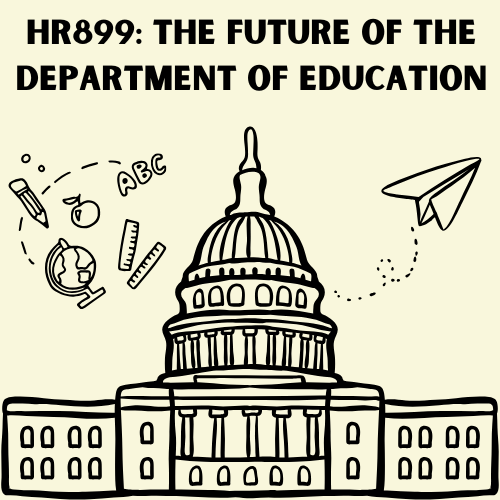U.S. Rep. Thomas Massie, R-K.Y., has reintroduced a bill that could abolish the U.S. Department of Education, with President Donald Trump following suit and drafting an executive order to hasten the process.
The U.S. Department of Education was originally established in 1867 to assist with the states’ formation of effective school systems. Starting as an office, its original responsibility began as providing land grants for universities and colleges in the nation. It later moved to provide federal aid for vocational education, expanded education opportunities for veterans following World War II, improved curricula in elementary and secondary schools, granted student rights through Title IX and provided financial aid for qualifying students.
Congress officially arranged the office into a cabinet-level federal agency in 1980. Since then, the department has managed every level of education in the country. According to its website, the Department of Education provides grants, loans and work-study programs to roughly 12 million students annually.
Numerous programs provided by the U.S. Department of Education, like Title I, are geared toward low-income communities. Title I provides federal funding for schools with students from low-income families an opportunity to receive “a fair, equitable and high-quality education” and allows for a higher allocation of resources, whether it is mental health resources or after-school programs.
Noraa Ransey, first-grade teacher and National Education Association (NEA) board member, works at a local Title I school in Calloway County. Ransey said the possibility of this funding disappearing threatens jobs.
“Directly the first thing right off the bat will be cuts to public education,” she said. “Many schools locally, 10% or more of the funds in their current budget come from federal dollars. If this happens and those cuts are made, that will be teacher layoffs. That will mean bigger class sizes, less attention to the most vulnerable students, and all three of those will affect every student, every teacher in our building.”
According to the Department of Education, education is a state and local responsibility. Ninety-two percent of funding comes from state, local and private sources, while 8% comes from federal funds. The Department’s Federal Role page describes its funding as “a means of filling gaps in state and local support for education when critical national need arises.”
While funding is a concern, the possibility of programs vanishing from public education is also a concern for educators.
The Individuals with Disabilities Education Act (IDEA) was enacted by Congress in 1975 to protect the rights of and meet the needs of disabled youth and their families. Before IDEA was established, schools educated one in five students with disabilities and numerous states had laws that barred students with certain disabilities from education. More than 8 million students with disabilities have received special education or similar services to meet their individual needs in the 2022-2023 school year, according to the IDEA website.
The Department of Education provides resources for families and schools, monitors public school districts for specific needs and provides technical assistance for state and local educational entities to administer IDEA.
Civil rights is another area of concern, especially considering Trump’s executive order to end Diversity, Equity and Inclusion (DEI) initiatives. Both Title VI and Title IX protect against discrimination and are established in institutions that receive federal funding.
Title IX, which is part of the Education Amendments from 1972, protects students from discrimination based on sex, sexual orientation and gender identity. This applies to numerous aspects of federally funded institutions including admissions, counseling, recruitment, financial assistance, athletics, employment and others.
Title VI is from the Civil Rights Act of 1964 and protects individuals against discrimination based on race, place of origin and color. Like Title IX, some of the same aspects and more apply to federally funded institutions, including libraries, museums and corrections facilities.
Tyler Murphy, Boyle County High School history teacher and NEA board member, said the main cause of concern is the redirection of funding streams.
“Title I, IDEA, the civil rights protections—all of those exist as separate, specific legislation,” he said. “Those funding streams are appropriated by Congress and, to my knowledge, this particular piece of legislation does not address any of that funding. The challenge is twofold. If you abolish the Department of Education, the responsibility for administering those funds will have to be transferred to different agencies. The whole reason the Department of Education was first created in the 70s is because that system wasn’t working, it was being treated as kind of a back burner issue. It wasn’t in the forefront … the appropriation of funds was slowed down because there wasn’t a department that voted for that purpose.”
Massie isn’t the first politician to introduce abolishing or minimizing the Department of Education. Former President Ronald Reagan called for the reduction of the Department of Education in 1982 during his State of the Union address, saying education decisions should remain at the local level and the federal government should only play a minor role in schools.
Along with the executive orders, numerous cuts to the federal budget are alarming government workers and citizens alike. Trump released an executive order on Jan. 20 that renamed the United States Digital Service Office to the United States Department of Government Efficiency (DOGE) office. This office’s purpose is to update federal technology to maximize the government’s productivity. Elon Musk, billionaire and founder of Tesla and SpaceX, heads the DOGE office and is making mass cuts to federal budgets.
Musk’s office ended contracts in the Department of Education totaling $900 million, 29 of those contracts centered around Diversity, Equity and Inclusion (DEI) training, according to a post on X from DOGE.



